17.2.1
1. 2024 Fishing-Village Revitalization World Café 2024漁村創生世界咖啡館
The event was held in Taichung on December 5, 2024, bringing together representatives from industry, government, academia, and research, with a total of 66 participants. The program was organized around four thematic strands: (1) fishing-village regeneration and community building; (2) fishing-village tourism and seafood education; (3) government support and public–private collaboration; and (4) marketing strategies and technological applications. Through this Fishing-Village Revitalization World Café, stakeholders concerned with the future of fishing villages convened to co-create pathways toward co-prosperity, coexistence, and sustainable development. The outcomes are intended to inform and support ongoing efforts by both government and civil society to advance the sustainable development of fishing villages.
Sustainable Impact: The "Fisheries Village Revitalization World Café," held in Kaohsiung on December 5, 2024, brought together 66 participants from industry, government, academia, and research sectors to discuss sustainable development of fishing communities. The event fostered multi-stakeholder collaboration and aligns with SDG 17.2.1, promoting partnerships that advance sustainability and strengthen coastal resilience.
本活動於113年12月05日假高雄蓮潭會館辦理,邀請產、官、學、研代表與會,共計66人參與,本次活動分為漁村再生與社區營造、漁村旅遊與食魚教育、政府支持與公私協力、行銷策略與科技應用四個議題進。透過本次漁村創生世界咖啡館,邀請關心漁村發展的權益關係人們共襄盛舉,共思漁村共好共生的永續發展路徑,作為政府、民間推動漁村永續發展之參考。
永續影響力:2024年12月5日於高雄舉辦的「漁村再生世界咖啡館」集結產官學研等66位參與者,討論漁村永續發展議題。活動促進多方利害關係人合作,符合SDG 17.2.1,推動促進永續發展與強化沿海韌性的夥伴關係。

Evidence:
2. Belgium On-Site Audit for Seafarer Professional Training Organizations in Taiwan
比利時來臺實地審查我船員專業訓練機構
Tom Clijmans, the Certification Officer of the Belgian Shipping Administration, and maritime investigator Els Huysmans visited the university to conduct a follow-up review of the STCW professional courses. Belgium has now approved 23 training programs, as well as the Chief Mate and Second Engineer Officer licenses, to be eligible for direct conversion to Belgian certificates based on the university's accredited certificates. Moreover, the original short-term six-month accreditation has been extended to five years. It is hoped that this collaboration with the Belgian Shipping Administration will enable Taiwanese seafarers currently working in the offshore wind industry to serve on European-class vessels and provide more diverse employment opportunities for other Taiwanese seafarers, helping them overcome challenges and expand their careers internationally.
Sustainable Impact:Representatives from the Belgian Shipping Administration, including Certification Director Tom Clijmans and Marine Inspector Els Huysmans, conducted an on-site review of NTOU's STCW professional courses. Following the audit, Belgium officially recognized 23 training programs and the Chief Officer and Chief Engineer certificates for direct equivalency and extended the certification validity from six months to five years. This partnership enhances NTOU's international maritime education credentials and opens new career pathways for Taiwanese seafarers in European vessels and offshore industries. The collaboration exemplifies SDG 17.2.1 by establishing a formal international partnership that promotes sustainable development and professional education alignment across borders, strengthening global maritime cooperation and workforce mobility
比利時航運總司認證主管Tom Clijmans及海事調查員Els Huysmans至校針對STCW專業課程再次審查,目前比利時針對23個訓練課程及一等船副和一等管輪同意使用本校認證之證書直接換發比利時證書,並由原僅有6個月的短期認證,延長至5年。期望此次與比利時航運總司之合作能讓目前已在離岸風電商工作之臺灣船員到歐洲級船舶上工作,並讓其他臺灣船員能有更多元的就業機會,讓臺灣船員更能突破困境向外發展。
永續影響力:比利時航運總司認證主管與海事調查員於本校進行STCW專業課程審查,確認23項課程及一等船副與管輪證書可直接換發比利時證照,並將原短期認證延長至五年。此舉提升本校航海教育之國際認可度,促進我國船員取得歐洲級證照之機會,拓展海外就業市場。此合作屬於政府與高等教育機構之正式夥伴關係,符合SDG 17.2.1「建立跨國合作促進永續發展」,展現學術機構與國際航運產業協作推動專業教育國際化的實質成果。
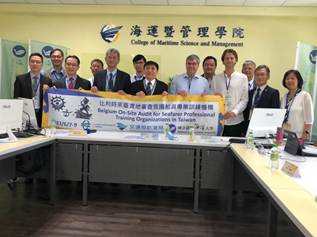

Evidence:
3. Early Career Ocean Professional (ECOP) Listening Sessions
早期職業海洋專業人士 (ECOP)聆聽工作坊
The listening sessions revealed that youth from diverse backgrounds in Taiwan—ECOPs, Indigenous youths, and young Ocean Educators—share strong concerns about marine pollution and ecosystem degradation. Across all groups, ‘Challenge 1: Understand and beat marine pollution' and ‘Challenge 2: Protect and restore ecosystems and biodiversity' were consistently ranked among the top three priorities. While the third priority varied, each group brought unique perspectives shaped by their experiences and professional or cultural contexts. All participants acknowledged that Taiwan has demonstrated significant strengths in marine ecosystem restoration and possesses the capacity to contribute valuable expertise and technology to global ocean sustainability. However, over 60% of ECOPs and Indigenous youth participants had never heard of the UN Ocean Decade, largely due to Taiwan's exclusion from formal UN processes. Despite Taiwan's fisheries and shipping sectors ranking among the top globally, it remains excluded from many international negotiations, resulting in a critical gap in global ocean data and perspectives. The participants called for more inclusive and culturally grounded ocean governance that integrates the knowledge and efforts of non-state actors, including Indigenous communities. Their collective messages urge that Taiwan's marine expertise and perspectives be meaningfully included in international dialogues—ensuring ocean sustainability efforts reflect diverse voices and local realities.
Sustainable Impact: This dialogue brought together Taiwanese youth from environmental, Indigenous, and educational sectors to discuss ocean governance and collaboration. It emphasized inclusive partnerships integrating Indigenous knowledge and non-state expertise to advance sustainable ocean management. The initiative aligns with SDG 17.2.1, strengthening global cooperation and multi-stakeholder engagement for marine sustainability..
聆聽環節發現,來自不同背景的台灣青年——環保青年、原住民青年和青年海洋教育者——都對海洋污染和生態系統退化有著強烈的擔憂。在所有群體中,「挑戰一:了解並戰勝海洋污染」和「挑戰二:保護和修復生態系統與生物多樣性」始終位列三大優先事項之列。雖然第三個優先事項各不相同,但每個群體都根據自身的經驗、專業或文化背景提出了獨特的觀點。所有參與者都承認,台灣在海洋生態系統修復方面展現出顯著優勢,有能力為全球海洋永續發展貢獻寶貴的專業知識和技術。然而,超過 60% 的環保青年和原住民青年參與者從未聽說過聯合國海洋十年,主要是因為台灣被排除在聯合國正式進程之外。儘管台灣的漁業和航運業在全球名列前茅,但它仍然被排除在許多國際談判之外,導致全球海洋數據和觀點有重大缺口。與會者呼籲更具包容性、以文化為基礎的海洋治理,整合包括原住民社群在內的非國家行為體的知識和努力。他們共同呼籲,將台灣的海洋專業知識和觀點有效納入國際對話,確保海洋永續發展努力反映多元聲音和本土現實。
永續影響力:本次對話集結來自環保、原住民與教育領域的台灣青年,共同探討海洋治理與合作。活動強調融合原住民知識與非政府專業的包容性夥伴關係,以推動海洋永續管理。此行動符合 SDG 17.2.1,強化全球合作與多方利害關係人參與,以促進海洋永續。
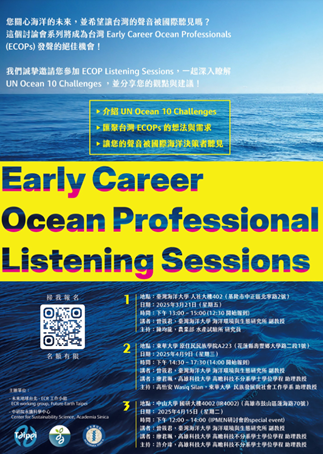
Evidence:
https://www.facebook.com/photo.php?fbid=691210616572785&id=100070515593897&set=a.220356423658209
4. Professional Service Project for the Training Mechanism of Maritime Administrative Investigators
海事行政調查人員訓練機制委託專業服務案
This project is carried out in coordination with the Maritime and Port Bureau, Ministry of Transportation and Communications, to develop domestic maritime administrative investigation procedures and related documentation. In collaboration with the Bureau, training programs for maritime administrative investigators are organized with the goal of cultivating professional maritime investigators. Corresponding courses and certification mechanisms are established to enhance the Bureau's administrative investigation capabilities and operational quality, ensuring that its investigations comply with relevant international standards and conventions.
Sustainable Impact:This project, in collaboration with the Maritime and Port Bureau, MOTC, focuses on establishing standardized procedures and documentation for maritime administrative investigations. It also includes professional training courses for maritime investigation officers, aiming to develop certified experts capable of conducting investigations that comply with international conventions and regulations.
By enhancing the Bureau's administrative efficiency and investigation capacity, the initiative strengthens institutional governance and fosters sustainable public sector development.This partnership exemplifies the principles of SDG 17.2.1, which promotes cross-sector collaboration, knowledge sharing, and capacity building to support sustainable institutional development and effective governance at both national and international levels.
本案與交通部航港局配合並研訂出國內海事行政調查流程及相關文件,並與航港局配合辦理海事行政調查人員之訓練,以培養專業海事行政調查人員為目標制定相關課程及認證機制,以幫助航港局提升行政調查能量與作業品質,並使其調查符合國際相關規範與章程要求。
永續影響力:本案與交通部航港局合作,針對海事行政調查制度進行流程設計與文件研擬,並共同辦理海事行政調查人員之專業訓練課程。其目標在於培養具備國際專業能力之調查人才,建立符合國際規範與章程的作業流程與認證制度,提升我國海事行政調查的品質與專業化程度。此計畫不僅促進政府與學術機構的跨部門合作,也提升公共部門之制度治理能力,推動專業知識、技術與經驗的共享,實踐 SDG 17.2.1 所強調的「透過夥伴關係強化制度能量與專業培育」,為我國海事安全與永續治理奠定基礎。


Evidence:
5. Participated in the "2024 Fishing Promotion and Fishery Production and Marketing Groups Guidance Work Liaison Meeting"
參加「113年度漁事推廣暨產銷班輔導工作聯繫會報」
The competent authority of the fishery promotion system is the Council of Agriculture of the Executive Yuan and the fishery-related units of various local governments. The Fisheries Agency of the Agriculture Committee of the Executive Yuan formulates fishery policies and allocates funds, and hand them over to the National Fishermen''s Association Taiwan and each district Fishery Association for implementation. And maritime academies are the technical support and guidance units for fishery promotion. The National Fishermen''s Association Taiwan holds a liaison meeting twice a year, invites counselors at all levels to attend the meeting, strengthens the counseling partnership, and puts forward relevant issues to feed back to the competent authorities.
Sustainable Impact:Taiwan's fisheries extension system is jointly managed by the Council of Agriculture (COA) and local governments.The Fisheries Agency under COA formulates national fisheries policies and allocates funding, while the National Fishermen's Association and regional associations implement extension activities.Technical support and guidance are provided by the Fisheries Research Institute and maritime universities.Two coordination meetings are held annually to foster collaboration among all extension personnel, discuss key policy issues, and provide feedback to authorities.This cooperative framework enhances communication, resource integration, and technical innovation, strengthening the partnership among government, academia, and industry in line with SDG 17.2.1 – Building partnerships to advance sustainable fisheries development.
漁會推廣體系的主管機關為行政院農業委員會及各地方政府的漁業相關單位,由行政院農業委員會漁業署擬定漁業政策與籌撥經費,交由全國漁會及各區漁會執行,水產試驗所及海事院校則為漁業推廣技術支援與指導單位。每年由全國漁會召開聯繫會報2次,邀請各級輔導人員與會,強化輔導夥伴關係,並提出相關議題回饋給各主管機關。
永續影響力:我國漁業推廣體系由行政院農業委員會及地方政府漁業單位共同管理,農業委員會漁業署負責政策擬定與經費籌撥,全國及各區漁會執行推廣任務,水產試驗所與海事院校則提供技術支援與專業指導。此體系每年召開兩次全國性聯繫會報,邀請各級輔導與推廣人員參與,交流政策執行經驗與漁業發展議題,強化產官學之間的夥伴合作關係。該制度有效促進資源共享與技術交流,強化漁業治理與永續經營,具體落實SDG17(夥伴關係促進目標實現)中強化多方協作推動永續發展的核心精神。
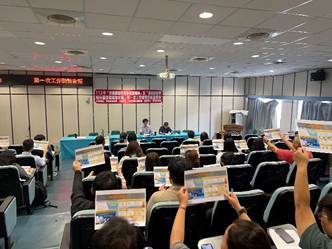

Evidence:
6. Seminar on Key National Defense Underwater Technologies NTOU
國防水下關鍵技術研討會 海大場
This seminar will delve into topics closely related to underwater technology, including underwater noise control, combat equipment testing, and underwater detection technology. Professor Emeritus Ke Yongze will deliver a speech titled "A Comprehensive Perspective on Ship Propeller Underwater Noise," deeply analyzing the impact of propeller noise on submarines and underwater equipment, and exploring how to effectively reduce underwater noise to enhance stealth and combat effectiveness. Distinguished Professor Xu Rongjun will analyze the Coast Guard Administration''s "Underwater Noise Guidelines and Noise Limits for Underwater Activities," elaborating on the coordinated development strategy between environmental protection and underwater technology development. Furthermore, Senior Researcher Wang Shengyao of the National Sun Yat-sen University of Science and Technology will share an analysis report on "Acceptance Testing of Combat Equipment at Various Stages," specifically focusing on the verification and testing standards for underwater combat equipment, showcasing the development and application of key technologies. Professor Qiu Yongsheng of National Sun Yat-sen University will share his insights on "Passive Acoustic Target Detection/Monitoring Technology and Sonar Hardware Development in the Waters Surrounding Taiwan," delving into the latest developments in passive acoustic technology for underwater detection and monitoring, as well as the application of sonar systems in modern underwater warfare.
Sustainable Impact:The symposium focused on underwater technology collaboration, bringing together experts from academia, research institutes, and government agencies.Topics included underwater noise control, defense system testing, and passive acoustic detection.Key speakers analyzed submarine propeller noise impacts, environmental noise regulations, and system verification standards.By facilitating dialogue between engineers, scientists, and policymakers, the conference strengthened cross-sector partnerships and encouraged sustainable innovation in marine technology.This event exemplifies SDG 17.2.1, promoting interdisciplinary cooperation, knowledge sharing, and joint development of technologies that balance environmental protection with maritime advancement.
本次研討會將深入探討水下噪音控制、戰系裝備測試、水下偵測技術等多個與水下技術密切相關的議題。柯永澤名譽教授將發表題為「船艦螺槳水下噪音面面觀」的演講,深入剖析螺槳噪音對潛艇與水下設備的影響,並探討如何有效減少水下噪音,提升隱蔽性與作戰效率。許榮均特聘教授則將解析海保署的「水下噪音指引與針對水下活動噪音限制」,說明環境保護與水下技術發展間的協同發展策略。 此外,國家中山科學研究院的王勝堯資深研究員將分享「戰系裝備的各階段接收測試」的分析報告,特別針對水下戰系裝備的驗證與測試標準,展示其關鍵技術的發展與應用。中山大學的邱永盛特聘教授將帶來「臺灣周邊海域之被動聲學目標偵/監測技術與聲納硬體發展」的分享,深入探討被動聲學技術在水下偵測和監控方面的最新進展,以及聲納系統在現代水下作戰中的應用。
永續影響力:本次研討會聚焦水下技術領域,邀集國內多所大學與研究機構專家共同探討水下噪音控制、戰系裝備測試及水下偵測技術等議題。柯永澤名譽教授剖析船艦螺槳噪音對潛艦隱蔽性的影響與改善策略;許榮均特聘教授說明海保署「水下噪音指引」及其在環保與技術發展間的平衡;王勝堯研究員與邱永盛教授分別分享戰系裝備測試標準與被動聲學監測技術。此研討會促進產、官、學三方的交流合作,推動海洋科技知識共享與永續技術研發,具體實踐SDG 17.2.1強調的「跨領域夥伴關係」精神,促進海事技術創新與環境永續發展。
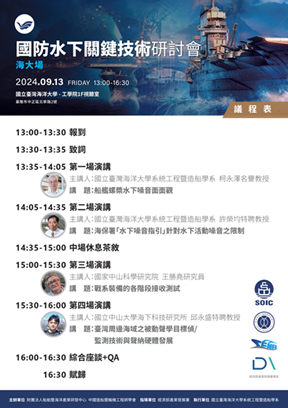

Evidence: https://se.ntou.edu.tw/p/406-1058-103049,r1062.php?Lang=zh-tw
7. Development of Mussel Seedling and Intermediate Breeding Technology
淡菜育苗及中間育成技術開發
In cooperation with the Fisheries Agency of the Ministry of Agriculture and the Lienchiang County Government, the Bachelor's Degree Program in Marine Biotechnology has been engaged in aquaculture-related research in the Matsu region since 2021. The initiative aims to strengthen the transformation of the local seafood sales model and enhance the food safety of aquatic products in the area. With its excellent water quality, Matsu produces mussels of superior quality compared to those from Taiwan's main island, giving it a competitive edge over imported products. As a result, Matsu has become Taiwan's largest mussel farming region. The Zhoushan Archipelago in China has a well-established mussel seed industry with mature breeding techniques. Due to Matsu's geographical proximity to the aquaculture areas of Fujian Province, local farmers have long relied on purchasing mussel seeds from across the strait. However, the Chinese authorities lack proper source control over the mussel industry, posing potential food safety risks to Taiwan's mussel supply chain. Therefore, it is necessary to leverage Taiwan's advanced bivalve breeding technologies to establish a long-term mussel hatchery base in Matsu, ensuring both industrial autonomy and food safety stability. This project is a continuation of previous research efforts. In 2023, the team successfully established preliminary techniques for mussel seed cultivation, completed local seed collection and intermediate culture trials, and set up onshore aquaculture facilities in Beigan, Matsu. The feasibility of mussel hatchery operations has been verified, and collaboration experience with local growers has been accumulated. Building on the 2023 outcomes, the 2024 project will further examine the reproducibility and mass production potential of mussel seed cultivation, while collecting comprehensive data on reproduction and growth to establish a stable intermediate culture system. On the technical front, the project will continue refining artificial mussel larval incubation methods and organize a “Technical Development Seminar and On-Site Demonstration on Mussel Seed Cultivation and Intermediate Culture,” inviting Matsu aquaculture farmers and representatives from the Fisheries Agency to participate. By leveraging Taiwan's aquaculture expertise, the project seeks to help Matsu produce mussel seeds locally, forming a production and marketing model of “Taiwan hatchery – Matsu grow-out – Taiwan sales.” This approach will reduce capital expenditure and transportation costs while utilizing existing marketing and logistics infrastructure to minimize the need for new channel development. In the mid- to long term, the project will expand local aquaculture capacity in Matsu to prepare for the establishment of a permanent hatchery base capable of supplying sufficient mussel seeds to local producers, thereby promoting sustainable industry development. With the establishment of mussel seed cultivation facilities, the project is expected to directly create job opportunities in aquaculture and nurture skilled professionals for the field. The localized breeding research outcomes can also be applied to develop modular aquaculture systems, support fishermen's career transitions, and facilitate fishery transformation, driving the overall upgrading and promotion of Matsu's aquaculture industry. From a social impact perspective, localized mussel seed cultivation is a crucial step in implementing the Lienchiang County Seafood Certification and Labeling System. Through a fully traceable production process—from seed, grow-out, to sales—the project aims to realize a transparent and verifiable “from seed to table” model. This integrated traceability system will strengthen risk management efficiency, enhance food safety assurance, and improve the brand image of Matsu mussels, establishing a new benchmark for sustainable and safe aquaculture in the region.
Sustainable Impact: The university’s Department of Marine Biotechnology collaborates with the Fisheries Agency and the Lienchiang County Government to establish a sustainable mussel hatchery program in Matsu. This initiative embodies SDG 17.2.1 by fostering partnerships between academia, government, and industry to promote sustainable aquaculture and regional development. The collaboration strengthens policy–industry integration and advances innovation for a resilient blue economy.
海洋生物科技學士學位學程配合農業部漁業署及連江縣政府合作,為強化臺灣馬祖地區水產品銷售模式轉型,並提升馬祖水產品之食用安全性,自2021年起即投入馬祖地區水生生物養殖相關研究。馬祖地區水質優良,所出產之淡菜成貝品質相對臺灣本島更佳,具備與進口產品競爭的優勢,因此目前馬祖已成為臺灣最大的淡菜成貝養殖地。 由於中國舟山群島一帶淡菜種苗產業聚落龐大,其種苗培育技術亦相當成熟,馬祖鄰近大陸福建養殖區,長期以來多向當地購買淡菜種苗。然而中國當局對淡菜產業並無完善的源頭管控,造成進口種苗在食用安全上存在風險,對我國淡菜產業影響甚鉅。為此,有必要運用臺灣在二枚貝種苗培育上的技術優勢,於馬祖設立長期運作的淡菜育苗基地,以供應當地業者使用,確保產業自主與食安穩定。 本計畫為延續性計畫。2023年度已初步建立淡菜種苗育苗技術,並完成馬祖在地淡菜苗體之採集與中間育成技術驗證,目前已於馬祖北竿地區建置陸上養殖設施,並確認淡菜育苗之可行性,具備與當地業者合作進行貝類中間育成的經驗。2024年度計畫將以2023年成果為基礎,持續探討淡菜育苗再現性與量產技術,並蒐集完整的繁殖及生長數據,以建立穩定的中間育成技術。 在技術層面上,計畫將持續改良人工孵育淡菜苗體之技術,並舉辦「淡菜育苗及中間育成技術開發說明會暨現勘活動」,邀請馬祖地區養殖業者及漁業署共同參與。預期藉由臺灣本島之水產技術優勢,協助馬祖產出淡菜種苗,形成「臺灣育苗、馬祖養成、臺灣銷售」的產銷鏈模式。此一模式可降低資本支出與運輸成本,並可依循既有的行銷與物流系統,減少新通路建置的負擔。中長期而言,將逐步擴增馬祖地區原有的養殖設備,為設置長期育苗基地做準備,達成穩定供應在地業者種苗的目標,促進整體產業的永續發展。 未來將隨著淡菜種苗培育場域的建立,預計可直接創造水產養殖業的就業機會,並培育專業人才投入相關領域,生產足夠之種苗以供應馬祖在地業者。同時,育苗技術自主化的研究成果亦可應用於養殖模組開發,進一步輔導漁民轉業及推動漁業轉型,帶動馬祖養殖產業升級與推廣。 此外於社會影響層面,淡菜在地自主培苗是連江縣落實水產品證明標章制度的重要關鍵。透過從種苗、掛養到銷售的一貫履歷作業,將可實現「從種苗到餐桌」的公開透明與可追溯機制,建立完善的風險管理體系,強化連江縣淡菜食品安全與品牌形象,為馬祖地區打造兼具產業效益與食安保障的水產新典範。
永續影響力:本校海洋生物科技學系與漁業署及連江縣政府合作,在馬祖推動永續貝類育苗計畫。此計畫體現 SDG 17.2.1,透過學術、政府與產業的夥伴關係,促進永續水產養殖與區域發展。此合作強化政策與產業的結合,推動創新與藍色經濟的永續韌性。
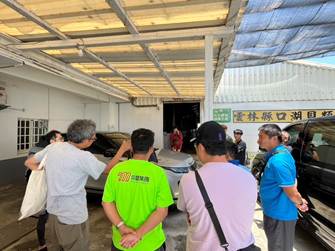

Evidence: https://usr.ntou.edu.tw/var/file/90/1090/img/1658/279782014.pdf
8. Guidance for Establishing a Friendly Aquaculture Production Model (Year 3)
輔導建立友善養殖生產模式(第三年)
Changhua's coastal areas boast rich and diverse ecosystems and fishery resources. The Changbin area has developed industrial zones, while the Hanbao, Wanggong, and Yongxing areas have reclaimed land for fish pond aquaculture, yet still retain Taiwan's largest mudflat wetlands and natural coastal landscapes. Changhua is one of Taiwan's main aquaculture production regions, with hard clams being the primary species farmed. The coastal aquaculture area in Changhua County spans nearly 1,600 hectares, primarily concentrated in Fangyuan Township (about 1,200 hectares), with several hundred hectares also in Fuxing and Shengang Townships. In recent years, extreme climate impacts (temperature fluctuations, sudden heavy rains, water shortages), combined with long-standing improper human management practices (overstocking, deteriorating nearby water sources), have led to poor aquaculture results and declining profits, severely affecting fishermen's livelihoods. The frequent abandonment of farming due to losses is detrimental to the industry's sustainable development. Under the guidance of the Fisheries Agency and the county government, the "Changhua County Aquaculture Youth Association" was established to integrate local youth energy and drive regional added-value growth. Founded in October 2020, it currently has 67 members spread across Changhua's three major aquaculture production areas: Hanbao, Wanggong, and Yongxing (see Figures 1, 2, 3). Given the escalating impacts of climate change making aquaculture management increasingly difficult, traditional experience-based methods can no longer cope with the unpredictable climate variations. Moreover, most association members have not received formal aquaculture education and training, making it challenging to effectively assess and address the challenges and issues arising during the aquaculture process, leading to unstable cultivation rates and difficulty improving operational performance. According to the United Nations Sustainable Development Goals (SDGs), sustainable and safe seafood supply chains have become an international development trend. However, most aquaculture operators pursue the highest profit per unit area, primarily adopting high-density intensive aquaculture models, with excessive feed and drug use, causing significant harm to aquaculture organisms and the ecological environment, and raising concerns about the quality and safety of seafood products.
Sustainable Impact: National Taiwan Ocean University supported the creation of the Changhua Young Aquaculture Alliance, integrating government, industry, and academia to promote sustainable aquaculture. This initiative exemplifies SDG17.2.1, fostering multi-stakeholder partnerships and cross-sector collaboration. Through shared knowledge and capacity-building, it strengthens local resilience and advances community-based marine sustainability.
彰化沿海擁有豐富多樣的生態與漁業資源,彰濱一帶有已開發之工業區,漢寶、王功與永興區多填海作為魚塭養殖使用但仍保有臺灣最廣大的泥灘濕地與自然海岸地景。彰化地區為我國養殖漁業主要產區之一,區內以文蛤為大宗養殖物種,彰化縣沿海養殖文蛤近1,600公頃,主要集中在芳苑鄉,多達1,200公頃,福興鄉和伸港鄉也有幾百公頃。近年因受極端氣候衝擊影響(溫差、突然性暴雨、缺水)加上長久以來人為管理方式不當(放養密度過高、附近水源惡化),導致養殖成效不佳收益逐年下滑,嚴重影響漁民生計,因不堪虧損而棄養之情事頻繁發生,不利產業永續發展。日前在漁業署及縣政府輔導下,成立「彰化縣養殖青年聯誼會」,希望整合在地青年能量帶動區域加值成長,成立於民國109年10月,現有會員67位,遍布彰化三大養殖生產區:漢寶養殖生產區、王功養殖生產區、永興養殖生產區,有鑑於近年氣候變遷衝擊加劇導致養殖管理日趨艱難,沿襲傳統之經驗法則已無法應付詭譎多變之氣候變化,加諸大部分聯誼會成員均未受過正規養殖教育訓練,對於養殖過程中所產生之挑戰與問題變化無法做出有效判斷與處置,導致育成率不穩,經營績效難以提升。 依據聯合國永續發展目標(SDGS),永續、安全之水產品供應鏈已成為國際發展趨勢,惟大部分養殖業者為追求單位面積最高獲利,多以高密度集約養殖模式為主,大量餌料投餵及藥物使用,對養殖生物及生態環境造成莫大危害,同時也產生水產品品質及安全性不佳之疑慮。
永續影響力:國立臺灣海洋大學協助成立「彰化青年養殖聯盟」,結合政府、產業與學術力量,共同推動永續水產養殖。此計畫體現SDG 17.2.1,促進多方利害關係人夥伴關係與跨部門合作。透過知識共享與能力培育,強化地方韌性並推進以社區為基礎的海洋永續發展。
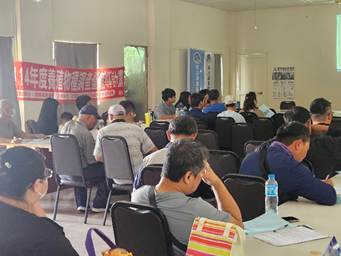

Evidence: https://www.fish1996.com.tw/4-1-7.html
9. MOU signing ceremony 簽訂合作備忘錄
NTOU and Université du Littoral Côte d'Opale Sign Sister University Agreement to Promote Smart and Sustainable Oceans On March 15, 2024, National Taiwan Ocean University (NTOU) welcomed delegations from Université du Littoral Côte d'Opale (ULCO) and Université de Picardie Jules Verne (UPJV). The delegation included Prof. Hassane Sadok, President of ULCO; Prof. Mohammed Benlahsen, President of UPJV; and ULCO Vice Presidents Prof. Sabine Duhame, Prof. Edmond Abi-Aad, and Prof. Rachid Amara. During the meeting, NTOU and ULCO signed a Memorandum of Understanding (MOU), officially establishing a sister university relationship. Both sides held in-depth discussions on smart aquaculture, green ports and transportation, and blue carbon research, aiming to promote collaboration in smart and sustainable ocean development. The delegation also paid courtesy visits to President Tai-Wen Hsu, Vice President Cheng-Yu Ku, Dean of International Affairs Prof. Yu-Wei Chang, and other faculty members. They toured departments including Aquaculture, Shipping and Transportation Management, and the Institute of Marine Environment and Ecology, gaining insight into NTOU's achievements in marine science and industry collaboration, laying a solid foundation for future partnership.
Sustainable Impact: National Taiwan Ocean University (NTOU) signed an MOU with Université du Littoral Côte d’Opale (ULCO) and Université de Picardie Jules Verne (UPJV) to establish a sister-university partnership. This initiative exemplifies SDG 17.2.1, fostering international collaboration and formal academic agreements that advance sustainable ocean development through joint research and innovation..
The delegation also met with President Tai-Wen Hsu, Vice President Cheng-Yu Ku, and Prof. Yu-Wei Chang, and toured academic departments to strengthen mutual understanding of marine science and industrial innovation.
海大與法國濱海大學締結姊妹校 合作推升智慧永續海洋 國立臺灣海洋大學於2024年3月15日接待法國濱海—珍珠海岸大學(Université du Littoral Côte d'Opale,ULCO)及法國皮卡第儒勒—凡爾納大學(Université de Picardie Jules Verne,UPJV)代表團。來訪成員包括ULCO校長Prof. Hassane Sadok、UPJV校長Prof. Mohammed Benlahsen,以及ULCO副校長Prof. Sabine Duhame、Prof. Edmond Abi-Aad與Prof. Rachid Amara等人。雙方於會談中簽署合作備忘錄(MOU),正式締結為姊妹校,並針對智慧養殖、綠色港口與運輸、藍碳等研究議題進行深入交流,期望共同推動智慧永續海洋的發展。訪團亦拜會許泰文校長、顧承宇副校長、國際長張祐維教授等校內師長,並參訪水產養殖系、航運管理系及海洋環境與生態研究所,深入了解海大在海洋科技與產學合作上的成果,為未來的國際合作奠定堅實基礎。
永續影響力:國立臺灣海洋大學與法國濱海海岸大學及皮卡第朱爾凡爾納大學簽署合作備忘錄,建立姊妹校夥伴關係。此合作體現SDG 17.2.1,促進國際合作與正式學術協議,透過共同研究與創新推動海洋永續發展。
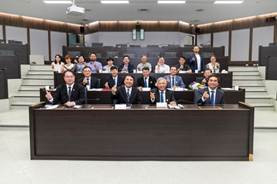

Evidence: